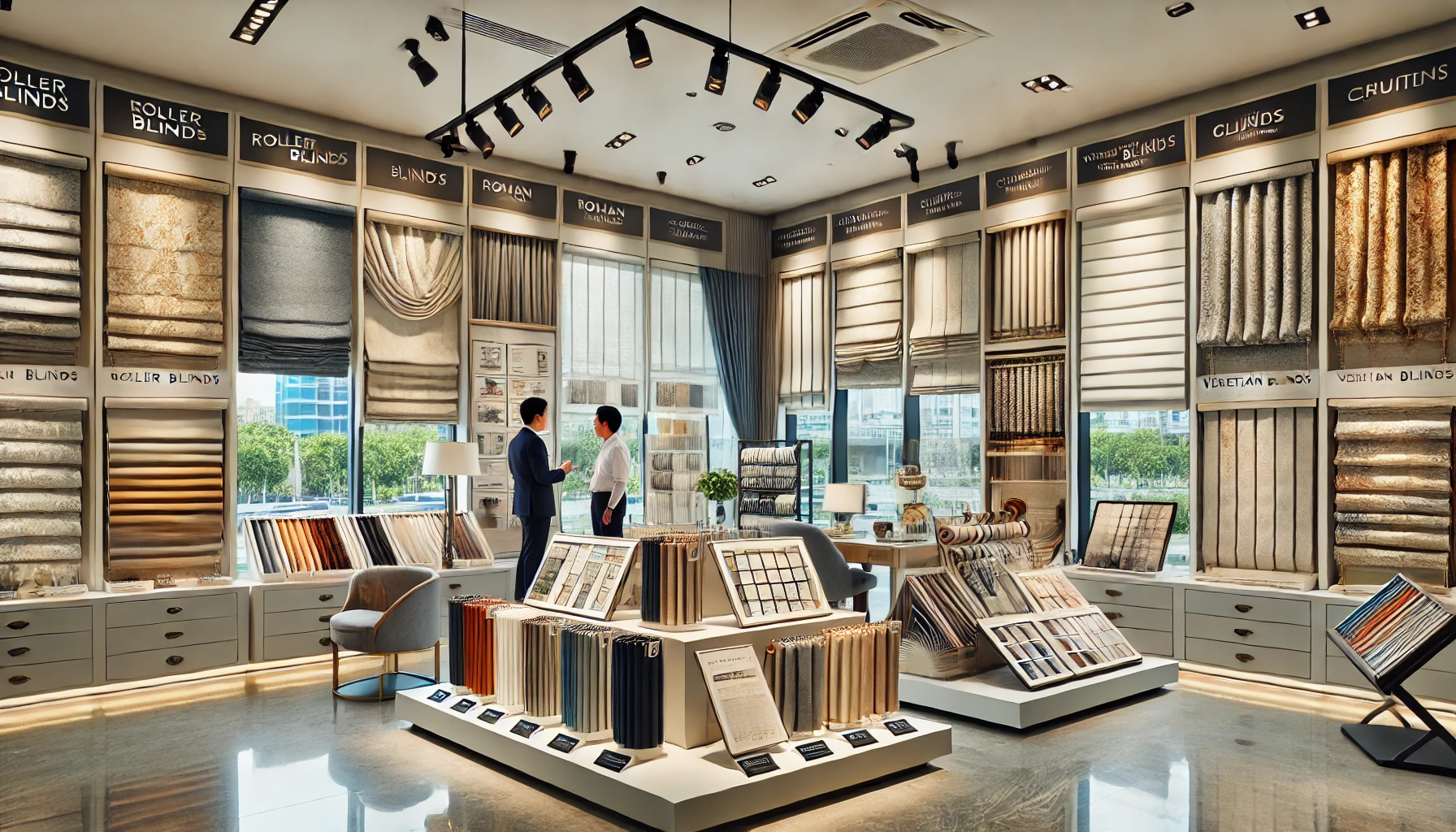Choosing the right window furnishings can be daunting.
With so many styles, materials, and options, it’s easy to feel overwhelmed and make choices that don’t fit your needs or style. This can leave your home looking mismatched and lacking functionality.
Our ultimate guide will help you navigate these choices, offering expert tips and insights to find the perfect window furnishings to enhance your home’s beauty and practicality.
Types of Window Furnishings
Choosing the right window furnishings can transform your space, but understanding the options is crucial. Here’s a detailed look at the main types of window treatments:
1. Curtains and Drapes
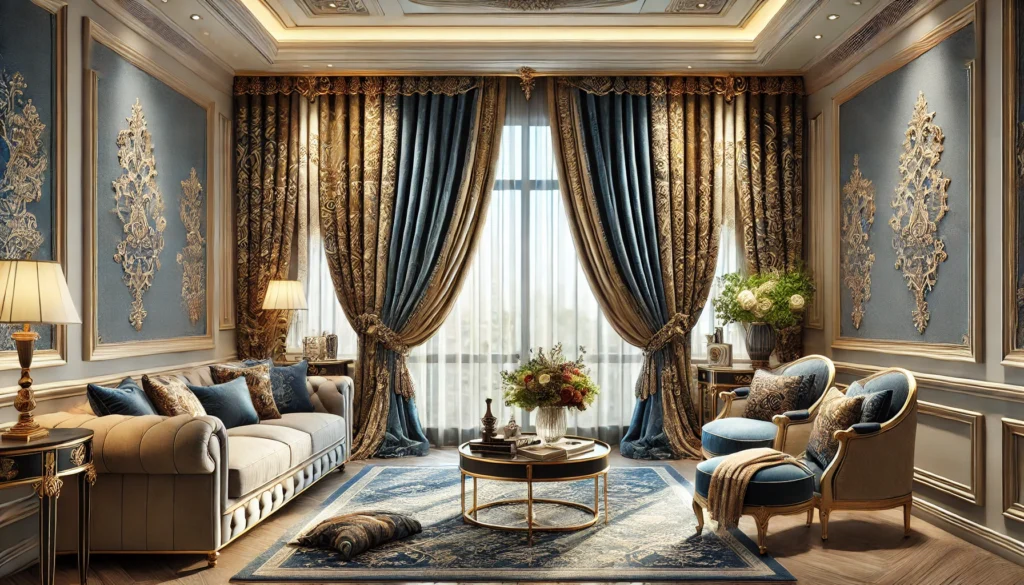
Curtains and drapes are classic window treatments that offer both style and functionality.
Curtains are typically made from lighter fabrics, making them ideal for creating a soft, airy feel in living rooms and bedrooms. They come in various lengths, patterns, and colours, allowing for versatile design options.
Drapes, conversely, are usually made from heavier, lined fabrics that provide better insulation and light control, perfect for bedrooms or rooms requiring more privacy.
Both curtains and drapes can be customised with various header styles, such as grommets, pleats, or rod pockets, to suit different décor preferences.
They can also be layered with sheer curtains for added dimension and light control.
Maintenance involves regular vacuuming or gentle washing, depending on the fabric. Properly chosen and maintained, curtains and drapes can enhance the elegance and comfort of any space.
2. Blinds
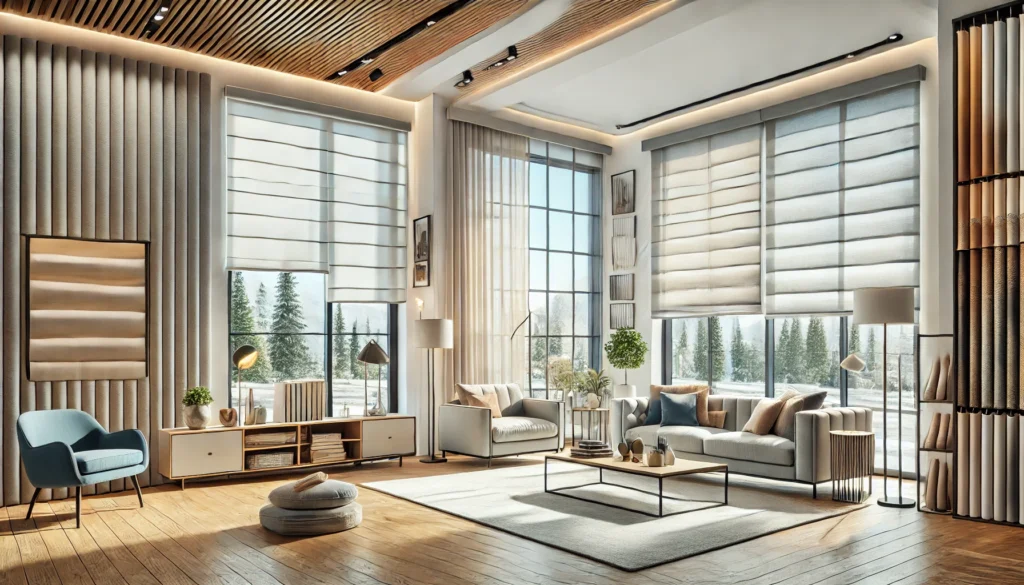
Blinds are a versatile and functional window treatment option offering excellent light and privacy control.
They come in various styles, as listed below:
- Venetian Blinds: These consist of horizontal slats, typically made from wood, aluminium, or PVC, which can be tilted to adjust the light entering the room. They are ideal for living rooms and offices where precise light control is needed.
- Roller Blinds: These are made from a single piece of fabric that rolls up and down. They are available in various materials, including bedroom blackout options and light-filtering fabrics for living areas.
- Roman Blinds: These fabric blinds fold into pleats when raised, offering a soft, elegant look. They suit formal and casual settings and come in various fabrics and patterns.
- Vertical Blinds: Comprising vertical slats that can be tilted and drawn to the side are perfect for large windows and sliding doors. They provide excellent light control and are available in fabric, PVC, and aluminium.
3. Shades
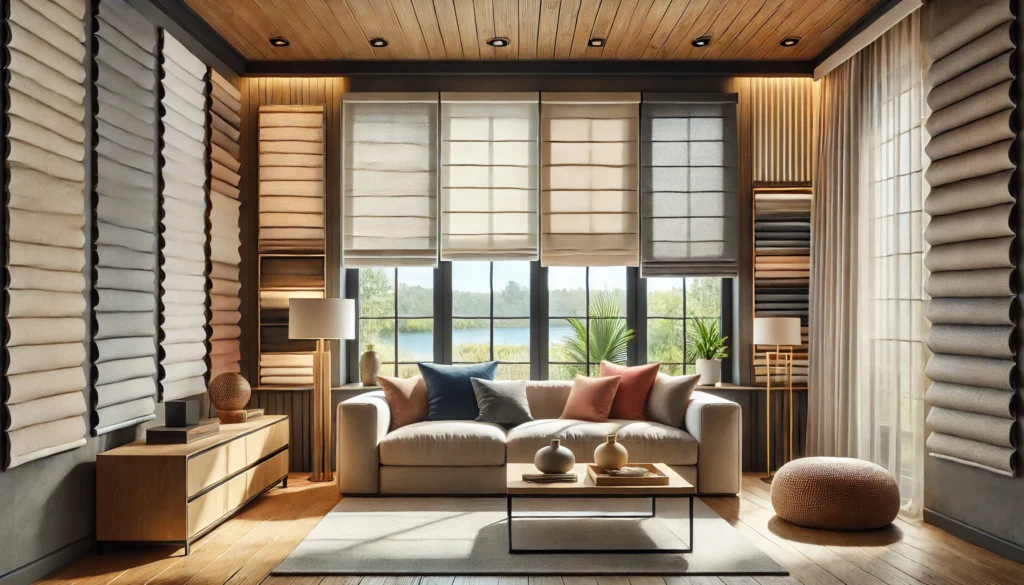
Shades are elegant and functional window treatments that offer a seamless look while providing excellent control over light and privacy.
They are available in various styles as below:
- Roller Shades: These are made from a single piece of fabric that rolls up and down. They are versatile and come in numerous materials, including blackout fabrics for bedrooms and light-filtering options for living areas. Roller shades are ideal for a clean, modern look and are easy to operate.
- Cellular Shades: Also known as honeycomb shades, these are designed with a unique cellular structure that traps air, providing excellent insulation. They are available in single, double, or triple layers, making them an energy-efficient choice for any room. Cellular shades offer both light-filtering and blackout options.
- Roman Shades: When raised, these fabric shades fold into neat pleats, offering a soft, elegant appearance. They come in a wide variety of fabrics and patterns, suitable for both formal and casual settings. Roman shades can provide full coverage or a more decorative, layered look when combined with drapes.
- Pleated Shades: Similar to cellular shades but without insulating cells, pleated shades feature crisp, pleated fabric that stacks neatly when raised. They offer a streamlined appearance and are available in various opacities to control light and privacy.
4. Shutters
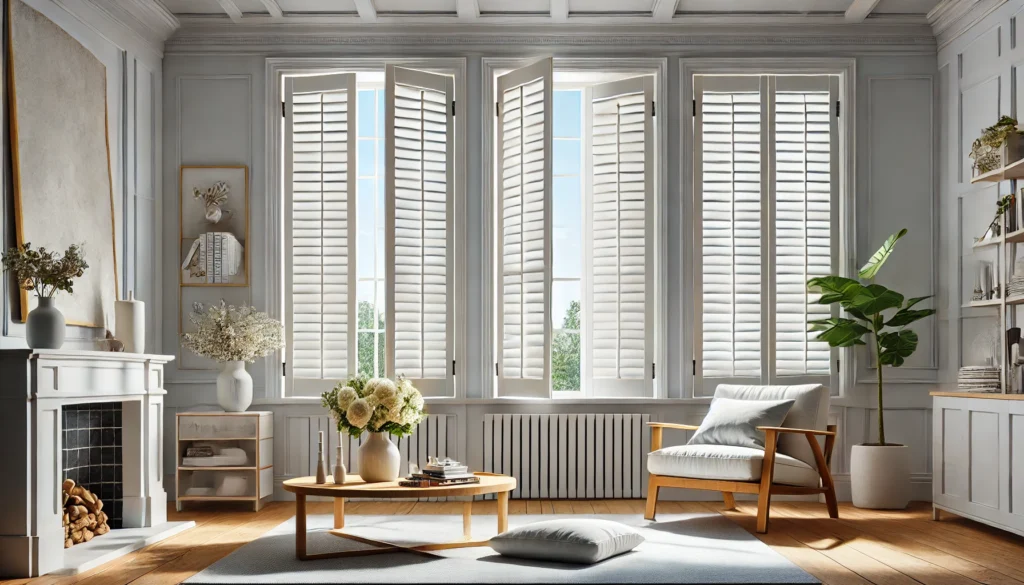
Shutters are a timeless and elegant window furnishing option that combines functionality with classic style. Known for their durability and excellent light control, shutters can be valuable to any home.
Below are some of them:
- Plantation Shutters: They are characterised by their wide louvres, which can be adjusted to control the amount of light entering the room. Plantation shutters offer excellent ventilation and privacy and are available in wood, composite, and vinyl. They are ideal for living rooms, bedrooms, and kitchens.
- Café Shutters: These cover only the lower portion of the window, allowing natural light to enter from above while maintaining privacy at eye level. Café shutters are perfect for ground-floor rooms, kitchens, and bathrooms, adding a charming, European feel.
- Tier-on-Tier Shutters: These feature two sets of shutters, one on top of the other, which can be operated independently. This design provides maximum flexibility, allowing you to open the top set for light while keeping the bottom set closed for privacy. They are suitable for large windows and versatile room layouts.
- Materials: Shutters are available in various materials, including solid wood for a traditional, high-end look and composite or vinyl for a more affordable, moisture-resistant option. Each material offers unique benefits in durability, maintenance, and aesthetic appeal.
- Maintenance: Shutters are easy to maintain, requiring only regular dusting and occasional wiping with a damp cloth. Their sturdy construction ensures they last for years, making them a worthwhile investment.
5. Valances and Cornices
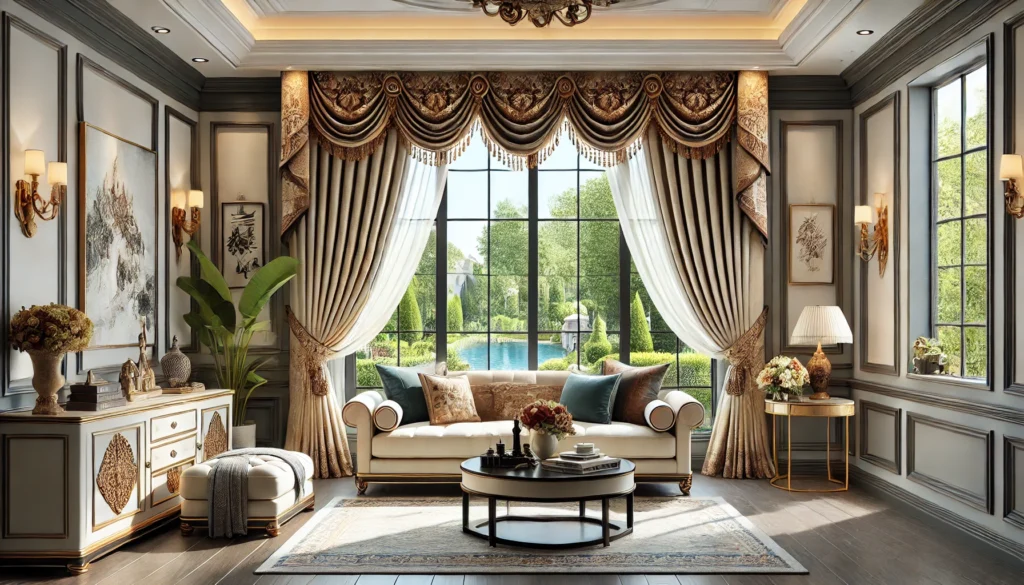
Valances and cornices are decorative window treatments that add a finishing touch to your windows while concealing hardware and enhancing the overall aesthetic of a room.
Here are the different types we offer:
- Valances: These fabric-based treatments hang across a window’s top. They come in various styles, such as swag, pleated, or gathered, and can be tailored to complement any decor. Valances can be used alone for a minimalistic look or layered over curtains and blinds for added elegance and depth. They are perfect for adding a soft, decorative element to living rooms, kitchens, and bedrooms.
- Cornices: Cornices are typically made from wood or other hard materials and are upholstered with fabric or painted to match the room’s decor. Unlike valances, cornices have a structured, box-like design that offers a more formal and polished appearance. They are excellent for concealing curtain rods, blind mechanisms, or other window treatment hardware. Cornices are ideal for creating a sophisticated look in formal dining rooms, offices, and bedrooms.
- Customisation: Both valances and cornices can be customised in fabric, colour, and design to match your interior style. Whether you prefer a simple, clean line or an elaborate, ornate design, these treatments can be tailored to suit your taste.
- Installation and Maintenance: Installing valances and cornices is relatively straightforward and can often be done as a DIY project. Maintenance is minimal, requiring occasional dusting or vacuuming to keep them looking fresh and clean.
Key Factors to Consider When Choosing Window Furnishings

Selecting the perfect window furnishings involves more than just aesthetics. Here are the key factors to keep in mind:
- Purpose: Determine the primary function of your window coverings. Do you need light control, privacy, insulation, or purely decorative elements? For instance, blackout curtains are ideal for bedrooms to block out light, while sheer curtains can create a light, airy feel in living spaces.
- Room-Specific Needs: Different rooms have different requirements. In the kitchen, moisture-resistant materials like PVC or aluminium blinds are practical. In bathrooms, consider privacy and humidity-resistant options. A combination of style and functionality is crucial for living rooms, while bedrooms may require solutions that enhance relaxation and sleep quality.
- Measuring: Accurate measurements are vital to ensure a perfect fit. Measure the width and height of your windows, considering whether you want an inside or outside mount. Detailed measurements can prevent ill-fitting furnishings that detract from your room’s appearance and functionality.
- Budget: Your budget will influence your choices. High-quality materials and custom designs come at a higher cost, but there are also affordable options that don’t compromise on style. Weigh the long-term benefits against the initial investment.
Material Choices and Their Impact

The material of your window furnishings plays a crucial role in their functionality and aesthetic appeal. Here’s what you need to know:
- Fabric: Fabric options, including cotton, linen, and polyester, are versatile and available in various colours and patterns. They are excellent for creating a soft, inviting look and can be used for curtains, drapes, and Roman shades. However, they require regular maintenance to keep them looking fresh.
- Wood: Wooden blinds and shutters add a touch of elegance and warmth to any room. They are durable and offer excellent light control and insulation. However, they can be expensive and unsuitable for high-moisture areas like bathrooms and kitchens.
- Aluminum: Aluminum blinds are lightweight, durable, and moisture-resistant, making them perfect for kitchens and bathrooms. They offer a sleek, modern look but may not provide the same level of insulation as other materials.
- PVC: PVC and faux wood blinds and shutters are budget-friendly, moisture-resistant, and easy to maintain. They are suitable for all rooms, including high-humidity areas, and mimic the look of wood without the cost.
- Environmental Impact: Consider your choices’ ecological footprint. Natural materials like wood and eco-friendly fabrics are more sustainable, while synthetic materials like PVC are less.
Colour and Design Tips
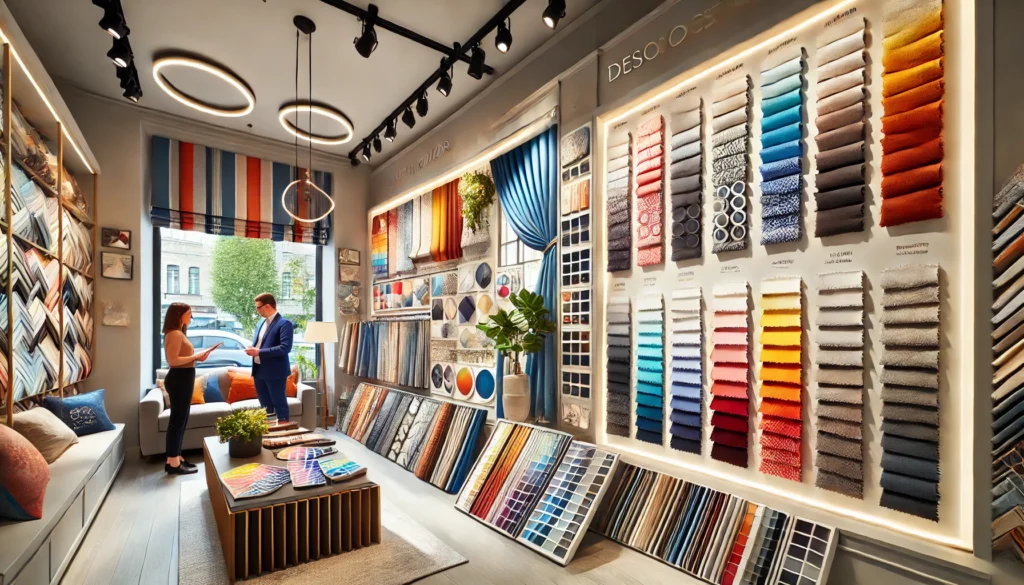
Choosing the right colour and design for your window furnishings can significantly impact your room’s overall aesthetic. Here’s how to make the best choices:
- Harmonise with Your Décor: Ensure your window furnishings complement your room’s colour scheme and style. Neutral colours like white, beige, and grey are versatile and blend seamlessly with various interior designs. Bold colours and patterns can create a focal point and add personality to a space.
- Consider the Room’s Function: The colour and design of your window treatments should align with the room’s purpose. For example, calming colours like blue and green are ideal for bedrooms, promoting relaxation. In contrast, vibrant colours like red and yellow can energise living areas and kitchens.
- Light and Space Perception: Light colours can make a room feel larger and more open, while darker shades create a cosy, intimate atmosphere. Opt for lighter hues to brighten the space if you have small windows or limited natural light.
- Trends and Timelessness: While it’s tempting to follow the latest trends, consider the longevity of your choice. Timeless designs and classic colours ensure your window furnishings remain stylish and relevant for years.
- Layering and Textures: Combining different textures and layering window treatments can add depth and interest to your design. For example, pairing sheer curtains with heavier drapes allows for versatile light control and a luxurious look.
Installation Tips and Considerations

Proper installation is essential for the functionality and appearance of your window furnishings. Here are essential tips and considerations:
- DIY vs Professional Installation: Decide whether to install the window treatments yourself or hire a professional. DIY installation can save money and be straightforward for simple treatments like roller blinds or curtains. However, for complex installations such as shutters or motorised blinds, professional help ensures precision and safety.
- Tools and Materials: Gather all necessary tools and materials before starting. Standard tools include a tape measure, drill, screwdriver, level, and appropriate screws and brackets. Having everything on hand will streamline the installation process.
- Accurate Measurements: Double-check your measurements to ensure a perfect fit. Measure the width and height of your windows, and decide on inside or outside mounts. Accurate measurements prevent gaps, providing optimal light control and privacy.
- Mounting Height and Position: Consider the height at which you mount your window treatments. Mounting curtains higher than the window frame can create the illusion of taller windows and add elegance. Ensure blinds and shades are mounted at the level and at the correct height for functionality and aesthetics.
- Safety Considerations: Ensure all window furnishings are securely installed to avoid accidents. Consider cordless options or secure cords out of reach for homes with children or pets to prevent entanglement hazards.
- Final Adjustments: After installation, make final adjustments to ensure everything operates smoothly. Check that blinds tilt and raise correctly, curtains slide easily, and shutters open and close without obstruction.
Maintenance and Care

Proper maintenance and care of your window furnishings extend their lifespan and keep them looking their best. Here’s how to ensure they remain in top condition:
- Regular Cleaning: Dust and dirt can accumulate on window treatments, affecting appearance and functionality. Regular vacuuming with an upholstery attachment helps remove dust from fabric curtains and drapes. Blinds and shutters can be wiped down with a damp cloth or dusted with a feather duster. For more thorough cleaning, follow the manufacturer’s instructions.
- Spot Cleaning: For minor stains on fabric treatments, use a mild detergent and a clean cloth to blot the area gently. Avoid harsh chemicals that can damage the fabric. For stubborn stains, consider professional cleaning services.
- Preventing Damage: To prevent damage, handle your window furnishings with care. Avoid pulling or tugging on curtains and blinds, and ensure cords and mechanisms are operated smoothly. For motorised treatments, follow the manufacturer’s guidelines to avoid mechanical issues.
- Inspection and Repair: Regularly inspect your window furnishings for signs of wear and tear. Check for loose brackets, fraying cords, or damaged slats. Promptly address any issues to prevent further damage. Replacement parts are often available from the manufacturer or retailer.
- Seasonal Maintenance: Perform a deep clean and thorough inspection of your window treatments at least once a year. This helps to address any accumulated dirt and identify potential problems early.
- Environmental Considerations: When cleaning and maintaining your window furnishings, consider the environment. Use eco-friendly cleaning products and methods to minimise your impact.
Conclusion
Enhance your home’s style and functionality with the perfect window furnishings. This guide provides the insights you need to make the right choice.
Don’t settle for drab coverings; embrace the possibilities and elevate your home’s style today!

